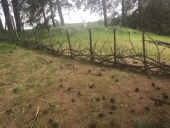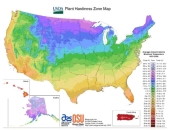
 2
2
















Bernard Welm wrote:I am no sure how well Hedge Apples grow here in MN. I have not seen many if any trees around (I am on the warmer side of Zone 4). I really would like it if they do grow here, because they sound like the ideal tree for hedgerows.
 3
3








Deb Stephens wrote:
Bernard Welm wrote:I am no sure how well Hedge Apples grow here in MN. I have not seen many if any trees around (I am on the warmer side of Zone 4). I really would like it if they do grow here, because they sound like the ideal tree for hedgerows.
Bernard,
You should definitely try to get some seeds or saplings if you are interested in them. According to everything I have had read (and know personally) about them, I'm sure they would do well where you are. If they can grow them throughout most of Canada, they'll grow in MN.
 1
1








Idle dreamer




 1
1




Idle dreamer












Tyler Ludens wrote:Deb, I bet this is the article: https://www.americanforests.org/magazine/article/trees-that-miss-the-mammoths/
 ) I started seriously considering growing some here on our land. I've loved them since I was a kid (for dumb kid reasons), but now I have good grown-up reasons to include them on the homestead.
) I started seriously considering growing some here on our land. I've loved them since I was a kid (for dumb kid reasons), but now I have good grown-up reasons to include them on the homestead.
 )
)




Deb Stephens wrote:Then a couple of months ago when I heard the NPR broadcast about the guy making more money from his hedge apples than his corn crop (we both posted the same link on that -- great minds think alike
) I started seriously considering growing some here on our land.
Deb Stephens wrote:You mentioned that the USDA plant database lists an entire state if a plant is only found in one portion of it, but the reverse is true as well. If a plant has been known to grow in a state, but it has not been officially documented, the entire state is left out. There is a LOT of leeway on those maps in both direction from my experience. You probably already know this, but for those who don't -- you can click on the state on the large U.S. map and it will zero in on the state showing counties where the plant has been reported. You can also find out more about the individual genus/ species within a family by going to the classification tab too.
Edit: Forgot to say that the USDA map shows incidences of plants found already growing in the state. It does not mean a plant cannot be grown there. If the climate is right, you can grow whatever you want in your own yard, whether it shows up on a map or not. (Unless it's illegal, of course.)
Deb Stephens wrote:One last thing, Tyler ... I noticed you mentioned a couple of Prunus species as living fence possibilities, which is great for a garden or field fence. However, if someone plans to keep livestock -- especially horses or goats -- inside a living fence, I would steer clear of any prunus species. The fresh leaves are usually okay, but dried leaves (from a fallen branch or from the autumn drop) can kill livestock if they eat them. The leaves contain cyanide, which is more concentrated as they dry.








 1
1




"Be kind, because everyone you meet is fighting a hard battle." --John Watson (Ian McClaren)








Gordon Haverland wrote:
Up here, the information I read on deer, is that they can jump a 14 foot fence. Will they jump over a 10 foot osage hedge? My feeling, is that if the hedge is taller than 15 feet, they won't try. And a hedge taller than 15 foot will not be browser to death by moose either.
"People may doubt what you say, but they will believe what you do."








Laboris Gloria Ludi- Work hard play hard




Tyler Miller wrote:
Hazelnuts/Filberts: Nut producing shrubs. Not thorny, but my understanding is that they were frequently used to make living fences in Europe. Beaked hazelnut (Corylus cornuta) and American hazelnut (Corylus americana) are both native to the U.S. and supposed to be quite cold hardy. The hazelnut commonly grown for commercial production, Corylus avellana, is not as hardy. Badgersett Research Corp has been working on hybrids of the commercial European hazels and native filberts to produce cold hardy, disease resistant productive plants. According to their website they're definitely hardy to Zone 4 and probably to Zone 3.
wilfredjr
33 acres kettle lake end moraine environs
Ice Age Trail Northern Wis CyB KnC KwD
http://twodogsgonewild.blogspot.com/
http://app.yardmap.org/map#!/map
 3
3




Box? what box?

|
Men call me Jim. Women look past me to this tiny ad:
Unlock Free Wood Plans! Download free projects and create unique pieces now!
https:/the-art-of-regenerative-wood-working/
|





